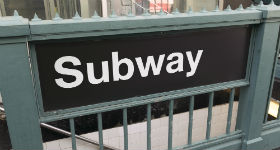Hudson Fiber Network Taps Subway to Bring Fiber Data to New York City
Fiber optic services are a rapidly growing part of the telecommunications field as we know it today. With more and more telecom firms offering this powerful breed of access, it's starting to become less a powerful option and more an expected service. To that end, Hudson Fiber Network has recently announced the completion of a bulk cable installation in Manhattan, New York, providing some major new access to the commercial buildings and data centers located in the borough.
With this new installation, several major data center operations—including those located at both 60 and 325 Hudson Street as well as 111 Eighth Avenue—now have access to both lit and dark fiber operations, with several more set to follow. The NYC cable arm, according to Hudson Fiber's chief operations officer Keith Muller, connects to the core network in New Jersey, which provides access to much faster speeds, much larger quantities of bandwidth, and the ability to provide lit and dark fiber access alike to larger numbers of locations. The average installation time is between 60 and 90 days, according to reports, and that provides “turnkey access” to fiber services for a wide array of locations in the region.
Hudson Fiber's CEO, Brett Diamond, also had some word about the installation, saying “This is a game changer for Manhattan’s commercial buildings requiring better access and competitive pricing for fiber optic services.”

Given that New York City accounts for about three percent of all Web traffic in the world, and counts about 8.3 million users to its credit along with 50 million annual visitors and a host of business users, getting proper connections in New York City becomes a vital part of the global economy. With Hudson Fiber itself ranked in the Inc. 5000 list of fastest-growing private companies, it's also clear just how big a part fiber is set to play in the changing online landscape.
After all, just back in late May, we heard about how Verizon was planning to go all fiber, if for no other reason than fiber was cheaper than copper. It's not out of line to suggest that other companies might do likewise, because fiber is no less expensive for Verizon than it would be for AT&T or any other company. Plus, considering the 800-pound gorilla in the room that is Google Fiber, it's not surprising to see more companies pre-emptively head off such advancement; Time magazine reportedly once remarked that the best way to get a free Internet service upgrade was to make a credible rumor that Google was planning to come to a particular area, then watch the local Internet service providers (ISPs) universally freak out and respond accordingly. But that takes fiber, and ISPs seem a lot more willing these days to get fiber going.
Fiber optics are changing the face of Internet access in big ways, and will likely continue to do so for some time to come. Watching the rollout of fiber can seem painfully slow, but with every bit of contribution like that of Hudson Fiber, the fundamental change takes shape.
Edited by Dominick Sorrentino

